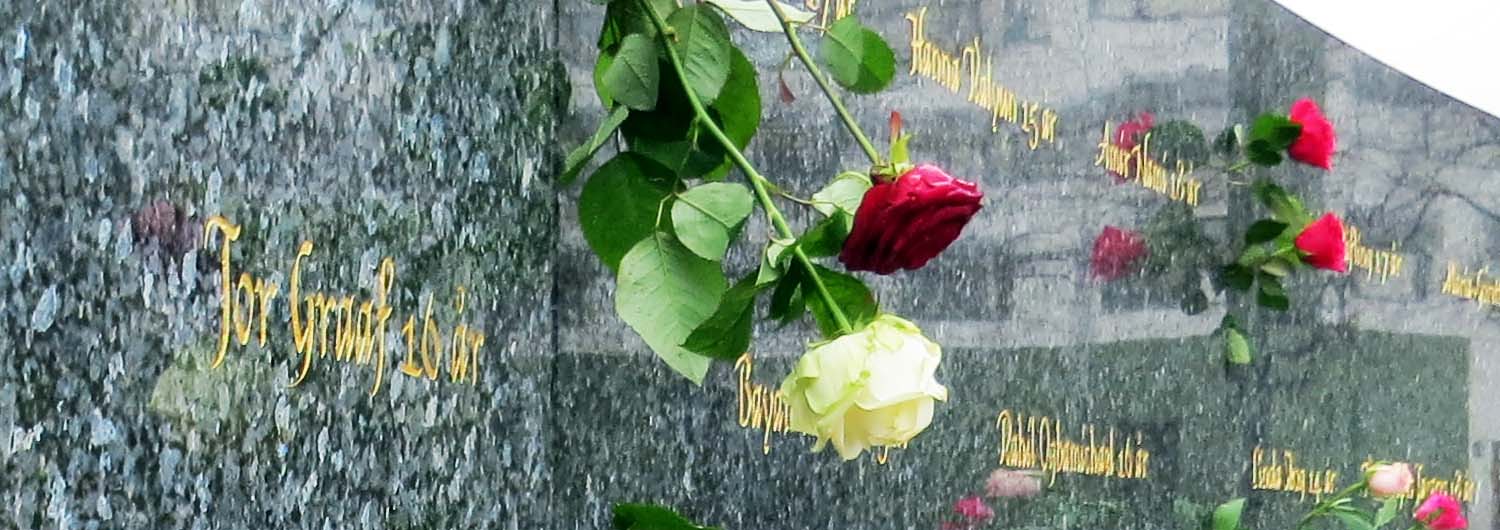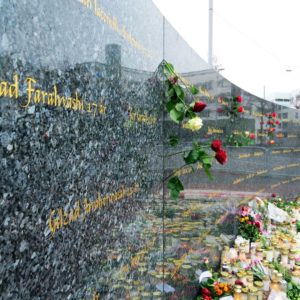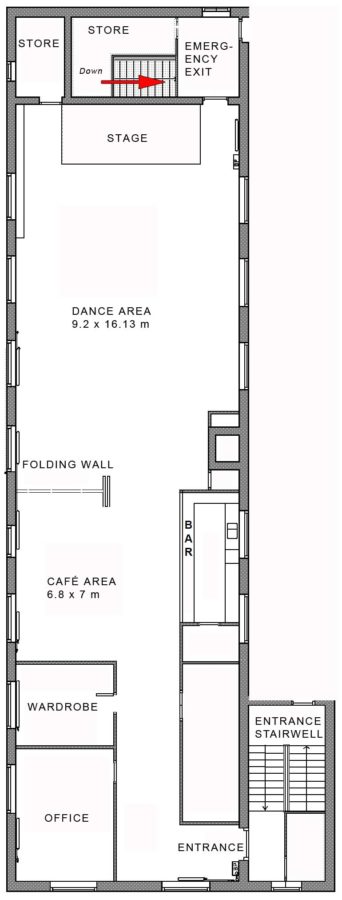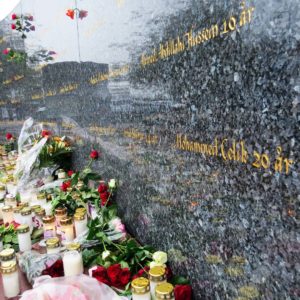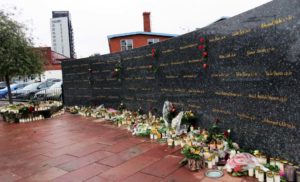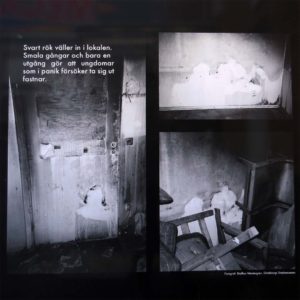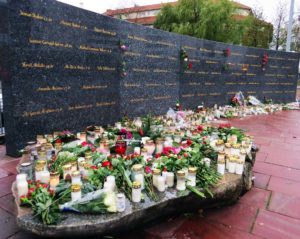Last week, the evening of Monday 29th October was dark and raw. Nevertheless a torch-lit procession formed in the city centre and snaked in the dark over the bridge and across the river, making its way to the site of the Gothenburg disco fire.
Twenty years ago, 63 teenagers died and over 200 were injured in the most fatal fire in modern Swedish history.
The disco fire
It’s called Diskoteksbranden in Swedish. The discotheque fire. I have to double check my spelling of “discotheque” as I can’t believe I’m right. (I am.) It’s clearly not a word I’m in the habit of writing. The Bee Gees Freak Out, Staying Alive on Saturday Night! That’s the Way (u-huh, u-huh) the Village People Will Survive.
In context, “disco” sounds so wrong; disco fire doubly so. But “discotheque fire”? That’s just a step too far. Diskotek – in the 90s it didn’t have to mean discotheque. It was used as a synonym for a place people went to dance. A nightclub. (What’s
the word now? Would it be a rave?) Some of the English-language reports on the fire chose to call it a “nightclub fire”. But, truly, it wasn’t anything like that.
Oh, I do not know. I was not there. But Mrs SC and I lived just a block away. We used to pass the building daily on our way to and from work. And now I’ve been reading the reports.
Near the Hjalmar Branting public transport interchange. A former industrial building – the old Gothenburg Bolt Factory – converted (sort of) for other purposes. There were shops, a shop selling beds and bedding in particular, and the premises of Backa Theatre. Nearby was a car showrooms. The Macedonian Club was in a long, narrow space on the third floor behind the theatre, partly partitioned into a few smaller rooms and one larger space. There was one entrance up a stairwell at one end. At the opposite end was an emergency exit. That led down another stairwell, through a long passage, out to the street.
Halloween
In my mind’s eye I see the long room, amateurishly decorated for a Halloween party. Some of the lights are dimmed with impromptu shades made from cardboard boxes. The decorations are festoons of spray cobwebs and ghoul-pumpkin-spider paper garlands. At one end, backing onto the fire exit, there’s a platform – a stage – for the DJs and their turntables. There are amplifiers and speakers. At the opposite end, at the entrance, there’s a table where someone sits with the cash-box, taking the entry fees and stamping wrists.
The windows are high above floor level, above head-height. They are wide side to side, but narrow up and down. You could roll through one, but climbing through would be difficult. And on the other side there’s a 6 m drop in the dark. We’re on the third floor. (A number of the children escaped the fire by squeezing out the windows to drop down outside. None suffered serious injuries from the fall.)
I read through the various things online about the fire. The report of the Accident Commission. An analyses of the progress of the fire by the Fire Safety Engineering Group at the the University of Greenwich (complete with animated simulations). Various news reports about the fire and the four arsonists once they were identified.
I’m wondering how one might try to write about what happened. How one might fictionalise it.
Imagine
I try and imagine myself into the heads of the protagonists. Into the heads of the organisers. I try to understand what they were thinking when they lied about the purpose of the party. Why did they tell the Macedonian Club representatives they were organising a private birthday party. Or did they not then know they would be advertising the party across the city with fliers and by word-of-mouth?
Perhaps they thought they’d get a better deal on the rental price if they said it was for a birthday party. Did they wanted to imply numbers – and so income – would be limited? Maybe they really believed it. Perhaps their confidence in the viral nature of their advertising campaign was not very strong.
I try to imagine how the Macedonian Club were thinking? Why didn’t they warn the party organisers about the limited numbers allowed in the premises at one time. Or did they not know? There seems confusion about that. The Accident Commission’s report suggests there was no official limit, though praxis should have been not to let more than 150 people in the room at any one time. When the fire broke out there were about 375 there.
Run-away success
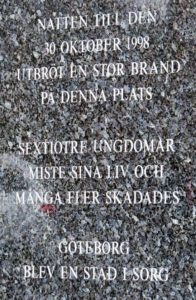
How did the organisers feel when they realised the run-away success the party was going to be. Were they worried? Or were they elated to see how the party had grown far beyond what they’d hoped. They certainly carried on. But were they carried away by their success? Did it ever cross their minds to try to limit the number of people coming in? If I’d been in their place and in my early twenties, would I have erred on the side of caution? I doubt it.
I try to see it from the point of view of the party-goers. The school kids – most of them were school kids – having fun and celebrating Halloween. Friends mixing in high spirits with new people from other parts of town. The sight of attractive strangers, the dreams of new relationships, the opportunity to try out dance moves. This was no party on school grounds. Here were no beady-eyed teachers, no parent kill-joys.
But the kids were responsible. They weren’t drinking, they weren’t doing drugs. (They said so and the Accident Commission’s report backs them up. This was corroborated, says the report, by samples taken from the deceased.) If they were high it was on a sense of freedom, and joy on the cusp of adulthood.
The arsonists
I try to imagine myself into the skins of the arsonists. The young men who were refused entry to the party because they didn’t want to pay the SEK 40 fee. (SEK 40 is a little over £3 or €4. OK, it was worth a bit more then than now, but it still wasn’t prohibitive. That was one of the things the organisers were trying to show – that it was possible to have a great party and not pay the exorbitant prices the real nightclubs were charging.)
I try to imagine the dynamic in that group of four. The youngest who wanted so much to be accepted into the gang he would do anything, accept any suggestion. There was the sporty guy who refused, when questioned, to see their group as a gang, because gangs are löjlig (ridiculous). There was the side-kick. And there was the ring-leader, the one who admitted to starting a “little” fire, but denied arson.
I follow them as, turned away from the party, they find their way to the back door. As they discover the passage through the building and the stairs that lead up to the back of the clubhouse. Their growing excitement as they struggle around the furniture stacked on the stairs and find themselves just behind the stage. And then their disappointment when they cannot open the door from outside. So, in revenge, they splash lighter fluid on the piled up furniture and set fire to it before running off the way they came.
SOS
I try to put myself into the head of the SOS Alarm receptionist who cannot at first understand the messages she is receiving. They’re garbled. There’s too much noise in the background. She is perhaps suspicious this is some sort of schoolkid prank. And where is this fire exactly? Behind the bed shop near to Hjalmar? Can you be more specific?
Then I’m trying to follow the fire crew from Lundby fire station, the first responders on their way to the fire. It took them just four minutes to get there. Not entirely sure exactly where the fire was, as they approached they saw flames and smoke. And then the kids, the crowds, the screaming. The seriousness of the situation dawned on them. They called for backup but then, distracted by the chaos that they had to cope with, they forgot to follow up. Forgot to double check that all the backup they’d asked for was actually on its way. (It wasn’t.)
Disaster
And now I’m trying to put myself in the heads of the parents as they receive the first frantic, disjointed calls. It’s their kids, or their kids’ friends. Or it’s the parents of their kids’ friends. And they’re phoning to ask, Do you have any news? Because there’s been some terrible accident. That Halloween feast the kids nagged about being allowed to attend. That dance where they’d promised to behave. That party all their friends were going to. It’s turning into a real horror. And we can’t get any answers.
And the parents start to call the emergency services. But the emergency services have no more information and they’re being inundated by all the calls. Everyone is trying to find out where their children are. My children! Our daughter! My son! And why do you have no information?
Nobody is prepared for a disaster on this scale.
The fire itself
Then I imagine myself as the fire itself. I burn bright in the stairwell outside the fire exit, but the door is nearly airtight. I am checked at the door, reduced to smoldering. Producing incendiary gasses, but without the oxygen to really blaze. Until somebody, curious about where the smoke is coming from, opens the fire-door, and immediately feeds me. And now I roar up the stairs like flames up a chimney. I leap into the dance hall to super-heat the room. I blaze and blow out the windows and suck in more air and burn hotter.
It took such a very short time.
And the children who died, like the dead in Hiroshima, left white shadows on the walls.
The casualties and the deceased
The casualties came from all across Gothenburg. Many were the children of immigrants, from a variety of different communities, but ethnicity was not a significant factor. More significant was the lack of opportunities (or the perceived lack) for teenagers of all backgrounds to party in Gothenburg at a reasonable price.
The deceased.
The eldest was 20 years old.
The youngest was 12.
Candles and flowers
For weeks after, the site of the fire was a place of pilgrimage for Gothenburgers. People left candles and grave lights, flowers and messages. These gifts filled half the pathway by the side of the road nearest the buildings for 200 meters. Even today, twenty years later, you can see some of the spilled candle-wax still preserved, welded to the asphalt of the pathway.
Three years after the fire the premises (no longer the Macedonian Club) were renovated and opened as a memorial space. They’re still in use as a meeting place for school classes to learn about the fire and about fire safety.
Ten years after, the polished granite monument, with the names and ages of all the dead picked out in gold, was inaugurated. It remains a place to visit for the families of the dead and the rest of us who remember. There are usually flowers and grave lights here, one or two, left I suppose by the families, on birthdays or other significant dates.
Now though, following the memorial parade, there’s a hundred candles. More! And flowers and messages.
It’s always a sad moment to pass or pause here. Now, at this time, that sadness is many times doubled.
I stayed away from the 20 year parade. It didn’t feel appropriate for me to bring my camera then. But I visited the memorial the day after, and again on a few days over the last week to take the pictures illustrating this.
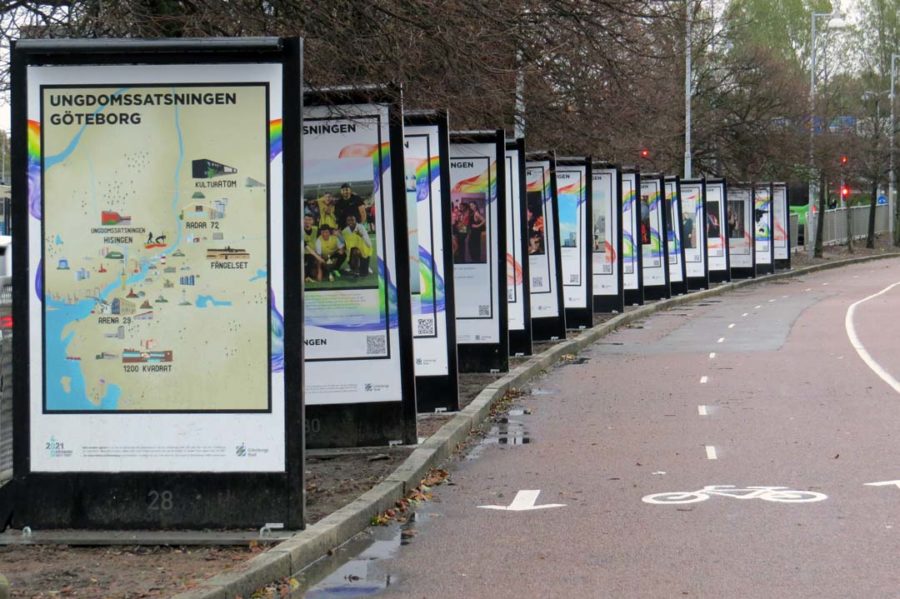
Notes
- Swedish Accident Investigation Authority: Factual information Discotheque Fire in Gothenburg
- Fire Safety Engineering Group at the the University of Greenwich: Analysing the Gothenburg fire
- B.O.A Brandoffrens Anhörig Förening (Fire Victims’ Relatives’ Association) – Facebook (in Swedish)
- BBC – Report of the court judgement on the four arsonists
I’m also publishing this article for the #Blogg52 challenge.

